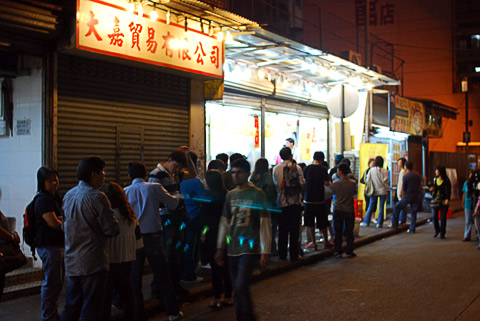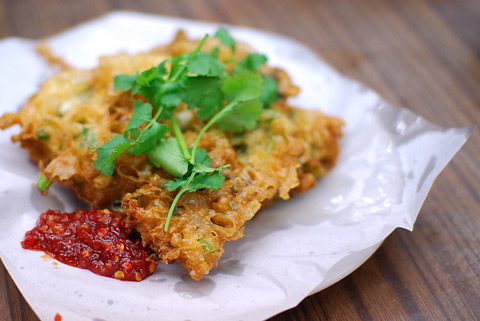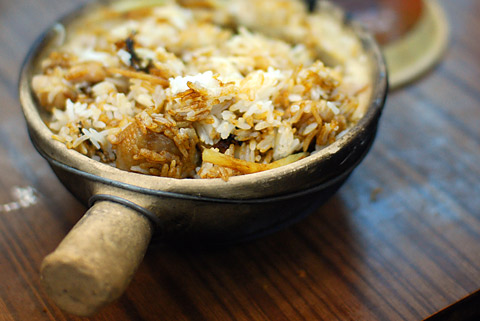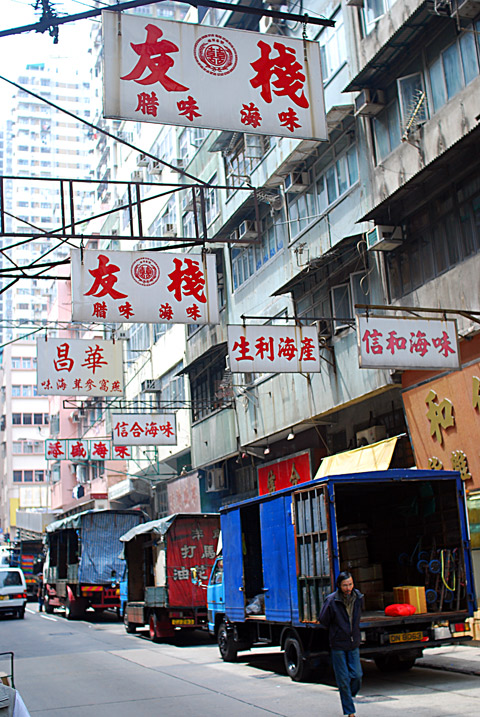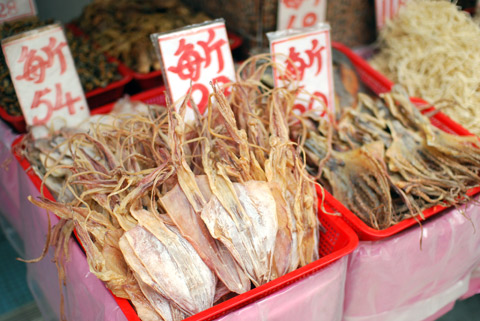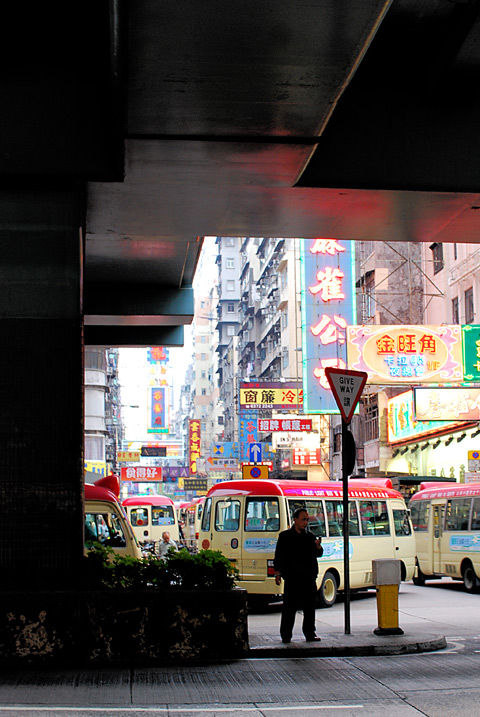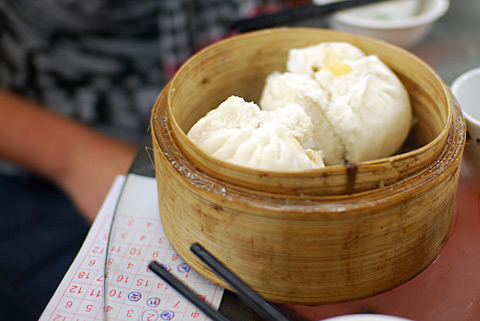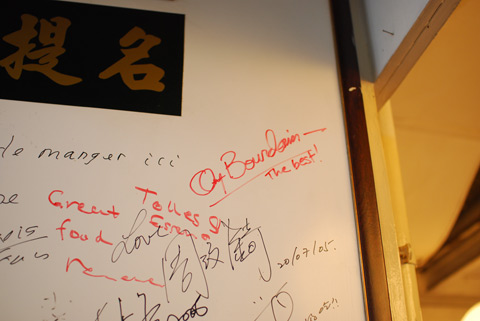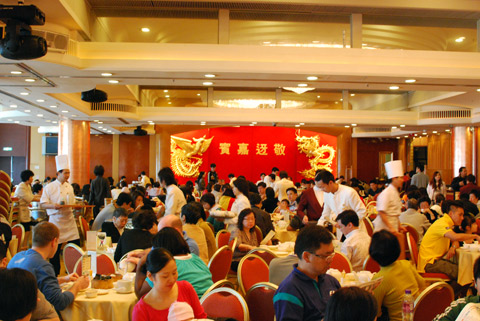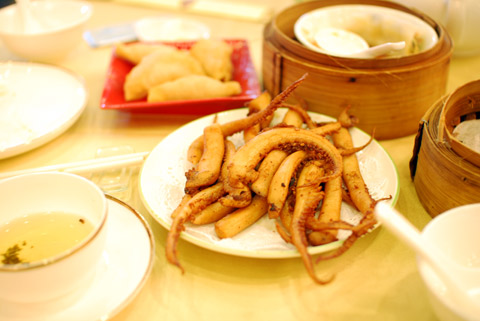Post Category → Hong Kong
I want to eat here
1950s and 60s restaurant postcards via SwellMap. Click left and right on the photo to scroll. So many white people.
Four Seasons Claypot Rice
When there is a queue of twenty people out the front, take the hint. It is either very good or super cheap.
Most of the time, I have a plan to eat my way around but after knocking back a handful of dumpling meals, I was satisfied by Hong Kong. This opened up the chance to eat at random. This joint , just near Temple Street, was doing a roaring trade in something that involved a giant stack of claypots which was reason enough to eat there.
Across the road is a hole in the wall place selling boiled offal in curry sauce. Once a family had joined the queue for the claypot joint, an emissary was sent over to the offal house to pick up a styrene clamshell of chopped tripe to see them through the queuing. Standing in line is reason enough to eat and the claypot restaurateurs were happy to let patrons bring in their own offal entree. This is probably a great measure of a food obsessed nation: that the only appropriate behaviour when waiting to eat is to eat something else. And there is always something else to eat at hand.
Once crammed into a communal table, I ordered what the people next to me ate.
Oyster omelette, deep fried until crispy with a sweet chilli sauce. This dish pops up all over Southeast Asia, but I’d never had it before in this crisp form.
Burnt claypot chicken rice; advertised as “Four Seasons Claypot Rice” on the menu. Rice is cooked in the claypot over a relatively high heat, which steams the chicken and burns a rich toasty layer of rice onto the bottom of the pot.
The local tactic for eating this dish is to pour a slug of soy sauce into the dish and then sit and wait for five excruciating minutes. The only two valid reasons that I can muster for the wait is firstly, the pot is damn hot; and secondly, maybe the extra liquid and steam from the soy lifts and softens the rice that is burnt onto the bottom of the pot. Maybe soy sauce represents the missing fourth season. If any claypot junkies can enlighten me, I’d love to know.
Meandering through Sheung Wan
Just to avoid the impression that I did nothing but eat dumplings in Hong Kong, I also spent a few lazy hours wandering the streets of Sheung Wan in a dumpling and pork induced stupor, planning which dumpling place I’d hit next and remembering dumplings past.
Sheung Wan is where the edible dried miscellany vendors hawk their wares. If you can dry it, someone here sells it as food or medicine. If you need a whole Yunnanese ham, one hundred kilos of fish maw or a bag of assorted turtle plastrons, this is where you will find it. As far as I know, of these three ingredients only one ends up in a dumpling.
Every store has a rich odor of its own, a musty smell that permeates even the passing trams on Des Vouex Road. I find it homely but it is probably not the olfactory overload that most tourists are seeking. You can always head over to the Flower Market Street over in Kowloon.
The surrounding alleyways are packed with small packing houses, distributors and vendors. Porters lug boxes in and out of trucks, and onto low-slung metal trolleys. A few streets specialise in abalone, bird’s nest and ginseng. Judging by the “No Photography” signs on the abalone vendors, I’d wager that a proportion of the abalone is smuggled.
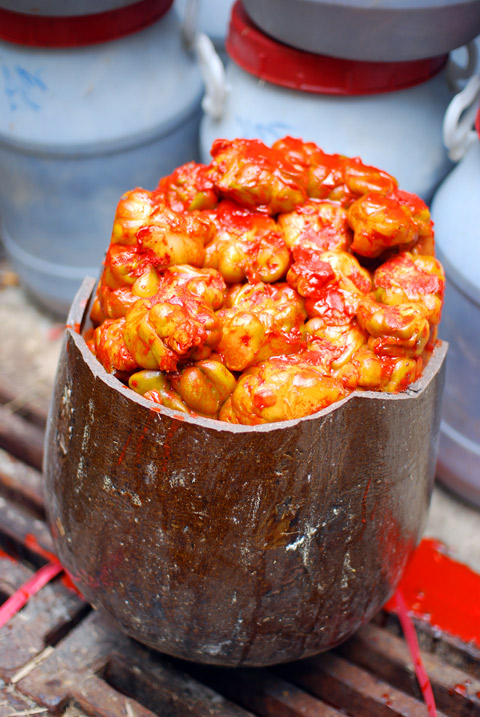
Pickled cabbage vessel, cracked and leaking lurid chili. Not everything stays intact.
Sending an SMS, Kowloon
Lin Heung, Hong Kong
Lin Heung is proof that the advice from random strangers on the Internet is better than anything published elsewhere. A commenter whom I’ve never seen before mentioned this dim sum joint amongst a handful of the sort of hawker stalls that pique my interest, so I decided to hit it up. Just because I don’t know you does not mean that I don’t trust you.
On a Sunday, Lin Heung is dim sum as competitive sport. Half of the trolleys enter the crowded, windowless room and a mob of ravenous Hong Kongers descend upon it, dim sum chit in hand. There are no clear patterns as to what particular dumplings are most sought after: the crowd seems self reinforcing. Hubbub causes further hubbub. Seating is communal, insofar as there is nowhere else to sit.
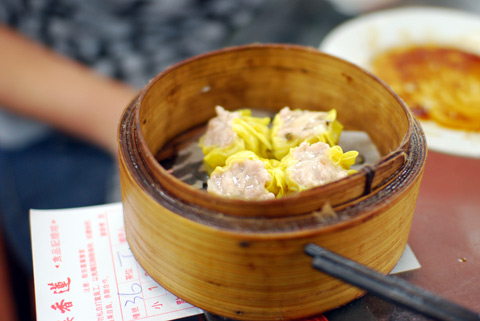
siu mai at Lin Heung, Hong Kong
Everything here surpasses their base ingredients. You can taste the chunks of roughly-cut roast pork in the siu mai.
Their tofu skin is light and barely toothsome; steamed beef balls are as beefy as whichever cut and organs were ground into them. This is the first time that I’ve seen people compete for simple plates of steamed offal. There is none of the premium dumplings; no prawns in anything that I could see. Seafood is on the menu but not off the cart.
The biggest commotion breaks out over their bao; steamed buns. The reason is obvious, the actual bun, normally a neutral and flavourless element is tasty. It tastes like a real bread not simply a indistinct white casing for pork or bean.
It is a very rare occasion that you can find a street vendor or restaurant that is elevating food and doing something greater than selecting the best components at their disposal then cooking them to order. As much as I enjoyed both Lung King Heen and Maxim’s this felt more like home.
Anthony Bourdain gave it his thumbs up. I think that he was onto something.
Location: 162 Wellington Street, Central, Hong Kong
City Hall Maxim’s Palace, Hong Kong
When people play the standards well, it is still exciting. To be sure, City Hall Maxim’s Palace isn’t the sophisticate jazz stylings of Lung King Heen but those culinary riffs wouldn’t exist without a benchmark. In Hong Kong dim sum, that ticking metronome is Maxim’s. They make the classics in plenteous quantity and they do it consistently well. Whatever your expectations are about Maxim’s dim sum, it is likely that they’ll be met.
After negotiating the queue, Maxim’s is like stepping into a Chinese wedding where you don’t know anyone. There’s a preponderance of movement, food, red and gold but the focus is getting you seated and a meal inside you at speed rather any nuptial function. The cheapish chairs and tables are somehow reminiscent of a suburban reception centre. It is a mixed crowd. Local families read newspapers while their children tend to their Pokemon, or whatever it is that children interact with on their Nintendos these days. Backpackers look bewildered.
Steaming trolleys rotate through the cacophonous hall, waitresses yelling out the names of their contents. I speak yum cha. I don’t know the words for “Goodbye” or even “Thank you” in Cantonese but I can ask for a plate of fried squid. It isn’t the most functional or appropriate way to know a language but I never go squidless. I probably sound like the rudest person in the room, but also, the hungriest. The waitstaff are au fait with you poking around on their trolley and taking your time. You could nurse a few dumplings for the best part of a morning. It would be the most pointless of mornings, but you could do it.
Anyhow, on with the dumpling porn
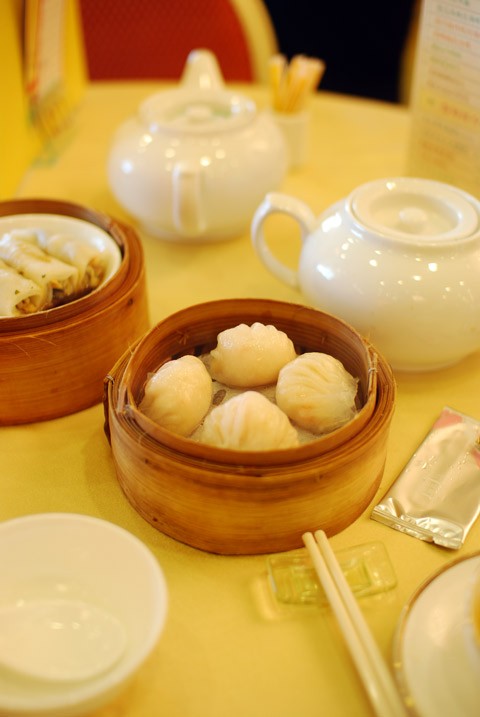
Har gau, two sizeable prawns lurk amongst the shredded bamboo shoot within. In the background is cheong fun but with chicken and shiitake instead of the usual prawn. Maybe Maxim’s does take the occasional liberty with dim sum standards.
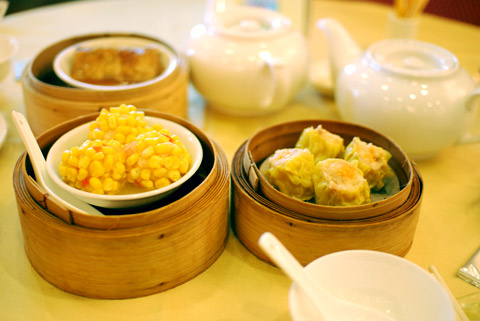
Siu Mai, plus corn and prawn ball that I picked out because it looked hilarious. Eating for one’s perverse sense of humour is probably not the best idea.
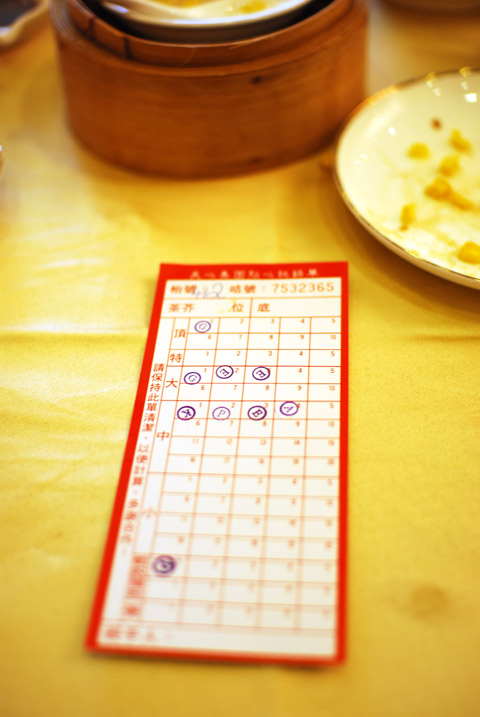
The damage: around HK$400 for two.
Address: 2nd Floor, City Hall Low Block, Hong Kong
Phone number: 852 2521 1303
Lung King Heen: 3 star dumplings

Scallop and prawn dumpling, Lung King Heen
It’s a strange thing to live in the bottom half of the planet that has no Michelin stars. In some ways, it has an internal logic for Michelin: the guide’s ostensible purpose was to get people out into the provinces by car and thereby burn through more Michelin rubber. Awarding stars to somewhere that can’t be accessed by automobile does not sell more French tyres. Hong Kong is one hell of a drive from France: it’s a possible but improbable journey, but the stars, they be there.
Maybe Michelin makes tyres for planes these days.
With low-cost carriers now offering flights for roughly the price of buying a beer onboard said plane, I thought that it was about time that I did some serious offshore eating and start collecting stars like a proper, credentialed food critic. Maybe it would convert me to the lifestyle of a high-end eater and my days eating delicious soup in the gutter would be over. I could credibly complain about foie gras and table linen like somebody that works for a serious but doomed print publication.
So I booked in for yum cha at Lung King Heen, Hong Kong’s only three Michelin-starred restaurant. I’m probably not making the most of the experience by eating dim sum but then again, what have I got to prove to anyone? I love dumplings. If I could take the chance at having a meal at the only Cantonese restaurant that Michelin has awarded three stars to, and have them make me a selection of dumplings I would. And did.
Critics probably like writing about serious dining because it gives you much more to write about. Filling a thousand words is easy when you eat twenty courses and you’ve got much more leeway to pick faults when you’re paying a huge bill at the end. They seated me five minutes late. The linen on the table was not perfectly flat. Service is obvious, cookie cutter silver service. English is great. The room is simple: wood panelling; huge windows frame Hong Kong’s harbour which is the “View of the Dragon” to which the restaurant’s name refers. These things are utterly meaningless when it comes to food, but maybe they’re supposed to matter to someone.
Physically, Lung King Heen’s menu has weight and silken texture. Inside, it’s much the same, classic Cantonese dishes subtly tweaked with premium ingredients and new presentation. It is a menu that plays with your memory of other Cantonese food from your past – if you don’t eat much of it, you’d never notice but if you’re an aficionado, I imagine that Lung King Heen’s head chef Chan Yan-tak is permanently winking at you from the kitchen.
There are both vegetarian and organic vegetarian options on the menu which must seem abhorrent to the average Cantonese chef, but if it’s bringing in the stars, maybe it matters. I skipped most of it for the dumplings but ordered roast suckling pig. On with the dumpling porn.
Xiao long bao come served on individual baskets; minimising the chances of puncturing the soup filled dumpling as you extract it from the steamer basket.
The roast suckling pig is presented separated; squares of rich meat topped with a square of pancake and a larger, thin pork skin hat. It’s tough to tackle with chopsticks and keep together in a single bite.
Sesame balls, unexpectedly filled with chunks of roast goose. Scallop dumplings have two whole scallops in them; spring rolls with sea whelk crispness on the outside and gooey interior with chunks of whelk that taste like the fresh sea. The pastry on the beef and morel dumplings tasted like unadulterated butter.
About ten dumplings in, the whole experience reminded me of Maytel from Gut Feeling’s assessment of Thomas Keller’s food:
I know that if I was to put an oyster with a big dolllop of caviar and cover it all in a butter sauce people would probably applaud me too
Top end dining seems to be caught in a self perpetuating cycle – you get lauded by Michelin, you ramp up the use of premium ingredients, you get lauded further. Lung King Heen’s use of luxury ingredients is still restrained and judicious amongst the dumpling menu but it could go awry very quickly.
Does Hong Kong need Michelin’s external validation? The locals already know that they’re onto a good thing and somehow quantifying that experience into a range of zero through three stars seems to do it a grand disservice. I’ve always found anonymous food reviewing somehow dishonest. We all bring our prejudices to the table and stating those prejudices brings out the best in critics; even if that prejudice is unadulterated dumpling love. I’m not looking forward to Michelin stepping south of the equator. We have our own laughable hat system.
Price: ~HK$400 a head
Location: Four Seasons Hotel, Fourth Floor, 8 Finance Street, Central, Hong Kong
Telephone. (852) 3196-8888
